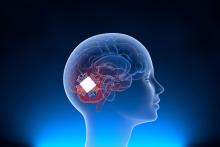Neuroscience and biomedical engineering have increasingly focused on neuromodulation technologies to treat a variety of neurological disorders, such as epilepsy, Parkinson’s disease, and chronic pain. Traditional approaches utilize permanent electrodes implanted in the brain to deliver electrical stimulation, aiming to regulate neural activity and promote brain repair. However, the invasive nature of these devices often necessitates additional surgeries for electrode removal and can lead to long-term adverse effects. This highlights a critical need for innovative solutions that provide effective neural stimulation while minimizing the risks associated with permanent implants.
Overview
This biodegradable electrode is engineered for temporary cortical implantation, featuring two parallel PLGA probes integrated with a molybdenum interconnect to facilitate effective neuromodulation.
The molybdenum layer dissolves at a controlled rate, ensuring safe and sustained stimulation over a therapeutic period of up to one week. After the molybdenum dissolves, the PLGA substrate gradually degrades, eliminating the need for surgical removal. In vivo tests demonstrate minimal inflammatory response, enhanced neuronal survival at eight weeks, and successful activation of neural precursor cells, highlighting its potential for targeted brain repair.
This technology distinguishes itself through its innovative combination of materials and precise degradation profile, addressing the limitations of conventional permanent electrodes. The use of PLGA offers flexibility and biocompatibility with a controllable degradation rate, while molybdenum provides superior electrochemical properties, including a wider electrochemical window and higher charge injection capacity compared to traditional materials like platinum and gold. The optimized coating enhances charge transfer efficiency and maintains performance throughout the stimulation period, minimizing harmful Faradic reactions. Additionally, the integration of a PLGA microchannel module allows for controlled drug delivery to support neuroplasticity and repair processes. Laser-based fabrication ensures precise micro-scale patterning, and in vivo studies confirm improved neuronal survival and effective neural precursor cell activation, positioning this device as an advanced solution for treating neurological disorders through NPC-mediated brain repair.
Benefits
Current neuromodulation methods face several significant challenges. Permanent electrodes can provoke inflammatory responses and tissue scarring, which degrade device performance and compromise neuronal health over time. Additionally, the requirement for surgical removal poses risks of infection and complicates patient recovery. Existing materials used for electrodes may lack optimal biocompatibility and appropriate degradation profiles, limiting their efficacy and safety for long-term applications. These limitations underscore the necessity for advanced, biodegradable electrode technologies that can safely perform their function without the drawbacks of traditional permanent implants.
- Elimination of removal surgery: Unlike permanent implants, which require risky explant procedures, this biodegradable electrode naturally dissolves after its therapeutic window, removing the need for a second surgical intervention.
- Superior electrochemical performance: offers higher charge injection capacity than platinum or gold electrodes, enabling more efficient neuromodulation with reduced risk of harmful electrochemical reactions.
- Reduced inflammatory response: In vivo tests show levels of neuroinflammation comparable to gold-based electrodes while avoiding the prolonged tissue irritation often seen with non-biodegradable metal implants over extended periods.
- Enhanced neuronal survival: Compared to conventional platinum or gold electrodes, long-term studies reveal superior neuronal viability at eight weeks, which is critical in fostering healthy tissue integration and improving outcomes for neural repair applications.
- Timed therapeutic window: By dissolving within approximately seven days, the device maintains optimal functionality when it is most needed, unlike conventional silicone-based or titanium-based probes that remain indefinitely and can interfere with later restorative processes.
Applications
- Temporary brain stimulation therapies
- Neural repair treatments
- Neuroprosthetics without removal
- Treatment of neurological disorders
- Controlled drug delivery systems
Opportunity
- Patent application submitted.
-
Seeking strategic partners for co‑development, grant support, and/ or licensing.





